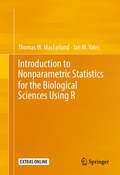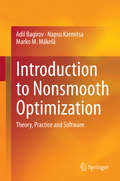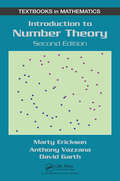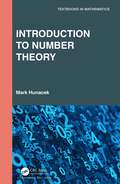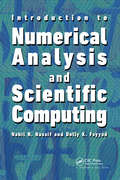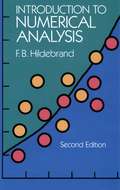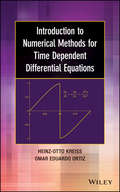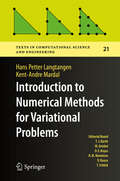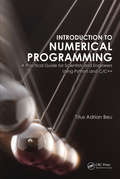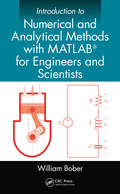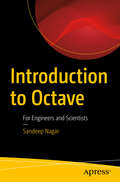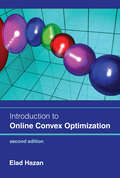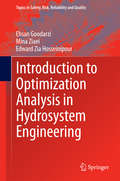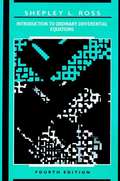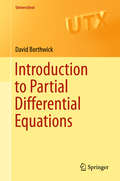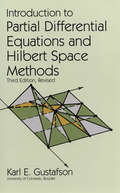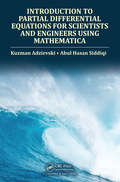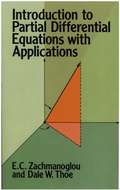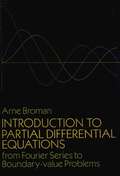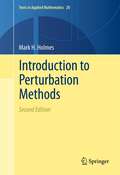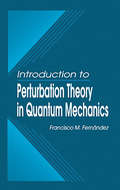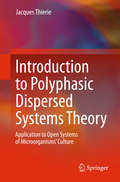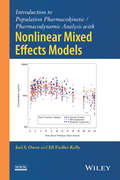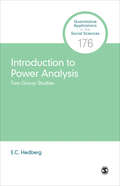- Table View
- List View
Introduction to Nonparametric Statistics for the Biological Sciences Using R
by Thomas W. Macfarland Jan M. YatesThis book contains a rich set of tools for nonparametric analyses, and the purpose of this supplemental text is to provide guidance to students and professional researchers onhow R is used for nonparametric data analysis in the biological sciences: To introduce when nonparametricapproaches to data analysis are appropriate To introduce the leadingnonparametric tests commonly used in biostatistics and how R is used togenerate appropriate statistics for each test To introduce common figurestypically associated with nonparametric data analysis and how R is used togenerate appropriate figures in support of each data set The book focuses on how R is used todistinguish between data that could be classified as nonparametric as opposedto data that could be classified as parametric, with both approaches to data classification covered extensively. Following an introductory lesson on nonparametric statistics for the biological sciences, the book is organized into eight self-contained lessons on various analyses and tests using R to broadly compare differences between data sets and statistical approach. This supplemental text is intended for: Upper-level undergraduate and graduate students majoring in the biological sciences, specifically those in agriculture, biology, and health science - both students in lecture-type courses and also those engaged in research projects, such as a master's thesis or a doctoral dissertation And biological researchers at the professional level without a nonparametric statistics background but who regularly work with data more suitable to a nonparametric approach to data analysis
Introduction to Nonsmooth Optimization
by Adil Bagirov Napsu Karmitsa Marko M. MäkeläThis book is the first easy-to-read text on nonsmooth optimization (NSO, not necessarily differentiable optimization). Solving these kinds of problems plays a critical role in many industrial applications and real-world modeling systems, for example in the context of image denoising, optimal control, neural network training, data mining, economics and computational chemistry and physics. The book covers both the theory and the numerical methods used in NSO and provide an overview of different problems arising in the field. It is organized into three parts: 1. convex and nonconvex analysis and the theory of NSO; 2. test problems and practical applications; 3. a guide to NSO software. The book is ideal for anyone teaching or attending NSO courses. As an accessible introduction to the field, it is also well suited as an independent learning guide for practitioners already familiar with the basics of optimization.
Introduction to Number Theory
by Anthony Vazzana David GarthIntroduction to Number Theory is a classroom-tested, student-friendly text that covers a diverse array of number theory topics, from the ancient Euclidean algorithm for finding the greatest common divisor of two integers to recent developments such as cryptography, the theory of elliptic curves, and the negative solution of Hilbert's tenth problem.
Introduction to Number Theory (Textbooks in Mathematics)
by Mark HunacekIntroduction to Number Theory covers the essential content of an introductory number theory course including divisibility and prime factorization, congruences, and quadratic reciprocity. The instructor may also choose from a collection of additional topics. Aligning with the trend toward smaller, essential texts in mathematics, the author strives for clarity of exposition. Proof techniques and proofs are presented slowly and clearly. The book employs a versatile approach to the use of algebraic ideas. Instructors who wish to put this material into a broader context may do so, though the author introduces these concepts in a non-essential way. A final chapter discusses algebraic systems (like the Gaussian integers) presuming no previous exposure to abstract algebra. Studying general systems helps students to realize unique factorization into primes is a more subtle idea than may at first appear; students will find this chapter interesting, fun and quite accessible. Applications of number theory include several sections on cryptography and other applications to further interest instructors and students alike.
Introduction to Numerical Analysis and Scientific Computing
by Nabil Nassif Dolly Khuwayri FayyadDesigned for a one-semester course, Introduction to Numerical Analysis and Scientific Computing presents fundamental concepts of numerical mathematics and explains how to implement and program numerical methods. The classroom-tested text helps students understand floating point number representations, particularly those pertaining to IEEE simple an
Introduction to Numerical Analysis: Second Edition
by F. B. HildebrandThe ultimate aim of the field of numerical analysis is to provide convenient methods for obtaining useful solutions to mathematical problems and for extracting useful information from available solutions which are not expressed in tractable forms. This well-known, highly respected volume provides an introduction to the fundamental processes of numerical analysis, including substantial grounding in the basic operations of computation, approximation, interpolation, numerical differentiation and integration, and the numerical solution of equations, as well as in applications to such processes as the smoothing of data, the numerical summation of series, and the numerical solution of ordinary differential equations.Chapter headings include:l. Introduction2. Interpolation with Divided Differences3. Lagrangian Methods4. Finite-Difference Interpolation5. Operations with Finite Differences6. Numerical Solution of Differential Equations7. Least-Squares Polynomial ApproximationIn this revised and updated second edition, Professor Hildebrand (Emeritus, Mathematics, MIT) made a special effort to include more recent significant developments in the field, increasing the focus on concepts and procedures associated with computers. This new material includes discussions of machine errors and recursive calculation, increased emphasis on the midpoint rule and the consideration of Romberg integration and the classical Filon integration; a modified treatment of prediction-correction methods and the addition of Hamming's method, and numerous other important topics.In addition, reference lists have been expanded and updated, and more than 150 new problems have been added. Widely considered the classic book in the field, Hildebrand's Introduction to Numerical Analysis is aimed at advanced undergraduate and graduate students, or the general reader in search of a strong, clear introduction to the theory and analysis of numbers.
Introduction to Numerical Methods for Time Dependent Differential Equations
by Heinz-Otto Kreiss Omar Eduardo OrtizIntroduces both the fundamentals of time dependent differential equations and their numerical solutionsIntroduction to Numerical Methods for Time Dependent Differential Equations delves into the underlying mathematical theory needed to solve time dependent differential equations numerically. Written as a self-contained introduction, the book is divided into two parts to emphasize both ordinary differential equations (ODEs) and partial differential equations (PDEs).Beginning with ODEs and their approximations, the authors provide a crucial presentation of fundamental notions, such as the theory of scalar equations, finite difference approximations, and the Explicit Euler method. Next, a discussion on higher order approximations, implicit methods, multistep methods, Fourier interpolation, PDEs in one space dimension as well as their related systems is provided.Introduction to Numerical Methods for Time Dependent Differential Equations features:A step-by-step discussion of the procedures needed to prove the stability of difference approximationsMultiple exercises throughout with select answers, providing readers with a practical guide to understanding the approximations of differential equationsA simplified approach in a one space dimensionAnalytical theory for difference approximations that is particularly useful to clarify proceduresIntroduction to Numerical Methods for Time Dependent Differential Equations is an excellent textbook for upper-undergraduate courses in applied mathematics, engineering, and physics as well as a useful reference for physical scientists, engineers, numerical analysts, and mathematical modelers who use numerical experiments to test designs or predict and investigate phenomena from many disciplines.
Introduction to Numerical Methods for Variational Problems (Texts in Computational Science and Engineering #21)
by Hans Petter Langtangen Kent-Andre MardalThis textbook teaches finite element methods from a computational point of view. It focuses on how to develop flexible computer programs with Python, a programming language in which a combination of symbolic and numerical tools is used to achieve an explicit and practical derivation of finite element algorithms. The finite element library FEniCS is used throughout the book, but the content is provided in sufficient detail to ensure that students with less mathematical background or mixed programming-language experience will equally benefit. All program examples are available on the Internet.
Introduction to Numerical Programming: A Practical Guide for Scientists and Engineers Using Python and C/C++ (Series in Computational Physics)
by Titus A. BeuMakes Numerical Programming More Accessible to a Wider AudienceBearing in mind the evolution of modern programming, most specifically emergent programming languages that reflect modern practice, Numerical Programming: A Practical Guide for Scientists and Engineers Using Python and C/C++ utilizes the author's many years of practical research and tea
Introduction to Numerical and Analytical Methods with MATLAB for Engineers and Scientists
by William BoberThis textbook teaches students how to write computer programs on the MATLAB platform and to use many of MATLAB's built-in functions to solve engineering-type problems. To students, MATLAB's built-in functions are black boxes. By combining a textbook on MATLAB with basic numerical and analytical analysis, the mystery of what the black boxes contain is somewhat alleviated. Within each chapter there are exercises related to the topics just covered. The text contains many examples from mechanical, civil, aeronautical, and electrical engineering.
Introduction to Octave
by Sandeep NagarFamiliarize yourself with Octave using this concise, practical tutorial that is focused on writing code to learn concepts. Starting from the basics, this book covers array-based computing, plotting, and working with files in Octave, which can run MATLAB files without modification. Introduction to Octave is useful for industry engineers, researchers, and students who are looking for open-source solutions for numerical computation. In this book you will learn by doing, avoiding technical jargon, which makes the concepts easy to learn. First you'll see how to run basic calculations, absorbing technical complexities incrementally as you progress toward advanced topics. Throughout, the language is kept simple to ensure that readers at all levels can grasp the concepts. What You'll Learn Apply sample code to your engineering or science problems Work with Octave arrays, functions, and loops Use Octave's plotting functions for data visualization Solve numerical computing and computational engineering problems with Octave Who This Book Is For Engineers, scientists, researchers, and students who are new to Octave. Some prior programming experience would be helpful but not required.
Introduction to Online Convex Optimization, second edition (Adaptive Computation and Machine Learning series)
by Elad HazanNew edition of a graduate-level textbook on that focuses on online convex optimization, a machine learning framework that views optimization as a process.In many practical applications, the environment is so complex that it is not feasible to lay out a comprehensive theoretical model and use classical algorithmic theory and/or mathematical optimization. Introduction to Online Convex Optimization presents a robust machine learning approach that contains elements of mathematical optimization, game theory, and learning theory: an optimization method that learns from experience as more aspects of the problem are observed. This view of optimization as a process has led to some spectacular successes in modeling and systems that have become part of our daily lives. Based on the &“Theoretical Machine Learning&” course taught by the author at Princeton University, the second edition of this widely used graduate level text features:Thoroughly updated material throughoutNew chapters on boosting, adaptive regret, and approachability and expanded exposition on optimizationExamples of applications, including prediction from expert advice, portfolio selection, matrix completion and recommendation systems, SVM training, offered throughout Exercises that guide students in completing parts of proofs
Introduction to Optimization Analysis in Hydrosystem Engineering
by Ehsan Goodarzi Mina Ziaei Edward Zia HosseinipourThis book presents the basics of linear and nonlinear optimization analysis for both single and multi-objective problems in hydrosystem engineering. The book includes several examples with various levels of complexity in different fields of water resources engineering. The examples are solved step by step to assist the reader and to make it easier to understand the concepts. In addition, the latest tools and methods are presented to help students, researchers, engineers and water managers to properly conceptualize and formulate resource allocation problems, and to deal with the complexity of constraints in water demand and available supplies in an appropriate way.
Introduction to Ordinary Differential Equations (4th Edition)
by Shepley L. RossFor those having knowledge of elementary calculus, this is a straightforward introduction to the basic concepts, theory, methods, and applications of ordinary differential equations. Designed for a one-semester course in ordinary differential equations, this book covers and emphasizes the most fundamental methods of the subject and also contains traditional applications and brief introductions to fundamental theory.
Introduction to Partial Differential Equations (Universitext)
by David BorthwickThis modern take on partial differential equations does not require knowledge beyond vector calculus and linear algebra. The author focuses on the most important classical partial differential equations, including conservation equations and their characteristics, the wave equation, the heat equation, function spaces, and Fourier series, drawing on tools from analysis only as they arise. Within each section the author creates a narrative that answers the five questions: What is the scientific problem we are trying to understand? How do we model that with PDE? What techniques can we use to analyze the PDE? How do those techniques apply to this equation? What information or insight did we obtain by developing and analyzing the PDE? The text stresses the interplay between modeling and mathematical analysis, providing a thorough source of problems and an inspiration for the development of methods.
Introduction to Partial Differential Equations and Hilbert Space Methods
by Karl E. GustafsonEasy-to-use text examines principal method of solving partial differential equations, 1st-order systems, computation methods, and much more. Over 600 exercises, with answers for many. Ideal for a 1-semester or full-year course.
Introduction to Partial Differential Equations for Scientists and Engineers Using Mathematica
by Kuzman Adzievski Abul Hasan SiddiqiWith special emphasis on engineering and science applications, this textbook provides a mathematical introduction to the field of partial differential equations (PDEs). The text represents a new approach to PDEs at the undergraduate level by presenting computation as an integral part of the study of differential equations. The authors use the computer software Mathematica (R) along with graphics to improve understanding and interpretation of concepts. The book also presents solutions to selected examples as well as exercises in each chapter. Topics include Laplace and Fourier transforms as well as Sturm-Liuville Boundary Value Problems.
Introduction to Partial Differential Equations with Applications
by E. C. Zachmanoglou Dale W. ThoeThis book has been widely acclaimed for its clear, cogent presentation of the theory of partial differential equations, and the incisive application of its principal topics to commonly encountered problems in the physical sciences and engineering. It was developed and tested at Purdue University over a period of five years in classes for advanced undergraduate and beginning graduate students in mathematics, engineering and the physical sciences.The book begins with a short review of calculus and ordinary differential equations, then moves on to explore integral curves and surfaces of vector fields, quasi-linear and linear equations of first order, series solutions and the Cauchy Kovalevsky theorem. It then delves into linear partial differential equations, examines the Laplace, wave and heat equations, and concludes with a brief treatment of hyperbolic systems of equations.Among the most important features of the text are the challenging problems at the end of each section which require a wide variety of responses from students, from providing details of the derivation of an item presented to solving specific problems associated with partial differential equations. Requiring only a modest mathematical background, the text will be indispensable to those who need to use partial differential equations in solving physical problems. It will provide as well the mathematical fundamentals for those who intend to pursue the study of more advanced topics, including modern theory.
Introduction to Partial Differential Equations: From Fourier Series to Boundary-Value Problems (Dover Books on Mathematics)
by Arne BromanThis exceptionally well-written and well-organized text is the outgrowth of a course given every year for 45 years at the Chalmers University of Technology, Goteborg, Sweden. The object of the course was to give students a basic knowledge of Fourier analysis and certain of its applications. The text is self-contained with respect to such analysis; however, in areas where the author relies on results from branches of mathematics outside the scope of this book, references to widely used books are given.Table of Contents:Chapter 1. Fourier series1.1 Basic concepts1.2 Fourier series and Fourier coefficients1.3 A minimizing property of the Fourier coefficients. The Riemann-Lebesgue theorem1.4 Convergence of Fourier series1.5 The Parseval formula1.6 Determination of the sum of certain trigonometric seriesChapter 2. Orthogonal systems2.1 Integration of complex-valued functions of a real variable2.2 Orthogonal systems2.3 Complete orthogonal systems2.4 Integration of Fourier series2.5 The Gram-Schmidt orthogonalization process2.6 Sturm-Liouville problemsChapter 3. Orthogonal polynomials3.1 The Legendre polynomials3.2 Legendre series3.3 The Legendre differential equation. The generating function of the Legendre polynomials3.4 The Tchebycheff polynomials3.5 Tchebycheff series3.6 The Hermite polynomials. The Laguerre polynomialsChapter 4. Fourier transforms4.1 Infinite interval of integration4.2 The Fourier integral formula: a heuristic introduction4.3 Auxiliary theorems4.4 Proof of the Fourier integral formula. Fourier transforms4.5 The convention theorem. The Parseval formulaChapter 5. Laplace transforms5.1 Definition of the Laplace transform. Domain. Analyticity5.2 Inversion formula5.3 Further properties of Laplace transforms. The convolution theorem5.4 Applications to ordinary differential equationsChapter 6. Bessel functions6.1 The gamma function6.2 The Bessel differential equation. Bessel functions6.3 Some particular Bessel functions6.4 Recursion formulas for the Bessel functions6.5 Estimation of Bessel functions for large values of x. The zeros of the Bessel functions6.6 Bessel series6.7 The generating function of the Bessel functions of integral order6.8 Neumann functionsChapter 7. Partial differential equations of first order7.1 Introduction7.2 The differential equation of a family of surfaces7.3 Homogeneous differential equations7.4 Linear and quasilinear differential equationsChapter 8. Partial differential equations of second order8.1 Problems in physics leading to partial differential equations8.2 Definitions8.3 The wave equation8.4 The heat equation8.5 The Laplace equationAnswers to exercises; Bibliography; Conventions; Symbols; IndexWritten on an advanced level, the book is aimed at advanced undergraduates and graduate students with a background in calculus, linear algebra, ordinary differential equations, and complex analysis. Over 260 carefully chosen exercises, with answers, encompass both routing and more challenging problems to help students test their grasp of the material.
Introduction to Perturbation Methods (Texts in Applied Mathematics #20)
by Mark H. HolmesThis introductory graduate text is based on a graduate course the author has taught repeatedly over the last ten years to students in applied mathematics, engineering sciences, and physics. Each chapter begins with an introductory development involving ordinary differential equations, and goes on to cover such traditional topics as boundary layers and multiple scales. However, it also contains material arising from current research interest, including homogenisation, slender body theory, symbolic computing, and discrete equations. Many of the excellent exercises are derived from problems of up-to-date research and are drawn from a wide range of application areas. One hundred new pages added including new material on transcedentally small terms, Kummer's function, weakly coupled oscillators and wave interactions.
Introduction to Perturbation Theory in Quantum Mechanics
by Francisco M. FernandezPerturbation theory is a powerful tool for solving a wide variety of problems in applied mathematics, a tool particularly useful in quantum mechanics and chemistry. Although most books on these subjects include a section offering an overview of perturbation theory, few, if any, take a practical approach that addresses its actual implementation
Introduction to Polyphasic Dispersed Systems Theory
by Jacques ThierieThis book introduces a new paradigm in system description and modelling. The author shows the theoretical and practical successes of his approach, which involves replacing a traditional uniform description with a polyphasic description. This change of perspective reveals new fluxes that are cryptic in the classical description. Several case studies are given in this book, which is of interest of those working with biotechnology and green chemistry.
Introduction to Population Pharmacokinetic / Pharmacodynamic Analysis with Nonlinear Mixed Effects Models
by Jill Fiedler-Kelly Joel S. OwenThis book provides a user-friendly, hands-on introduction to the Nonlinear Mixed Effects Modeling (NONMEM) system, the most powerful tool for pharmacokinetic / pharmacodynamic analysis. * Introduces requisite background to using Nonlinear Mixed Effects Modeling (NONMEM), covering data requirements, model building and evaluation, and quality control aspects * Provides examples of nonlinear modeling concepts and estimation basics with discussion on the model building process and applications of empirical Bayesian estimates in the drug development environment * Includes detailed chapters on data set structure, developing control streams for modeling and simulation, model applications, interpretation of NONMEM output and results, and quality control * Has datasets, programming code, and practice exercises with solutions, available on a supplementary website
Introduction to Power Analysis: Two-Group Studies (Quantitative Applications in the Social Sciences #176)
by E. C. HedbergIntroduction to Power Analysis: Two-Group Studies provides readers with the background, examples, and explanation they need to read technical papers and materials that include complex power analyses. This clear and accessible guide explains the components of test statistics and their sampling distributions, and author Eric Hedberg walks the reader through the simple and complex considerations of this research question. Filled with graphics and examples, the reader is taken on a tour of power analyses from covariates to clusters, seeing how the complicated task of comparing two groups, and the power analysis, can be made easy.
Introduction to Power Analysis: Two-Group Studies (Quantitative Applications in the Social Sciences #176)
by E. C. HedbergIntroduction to Power Analysis: Two-Group Studies provides readers with the background, examples, and explanation they need to read technical papers and materials that include complex power analyses. This clear and accessible guide explains the components of test statistics and their sampling distributions, and author Eric Hedberg walks the reader through the simple and complex considerations of this research question. Filled with graphics and examples, the reader is taken on a tour of power analyses from covariates to clusters, seeing how the complicated task of comparing two groups, and the power analysis, can be made easy.
